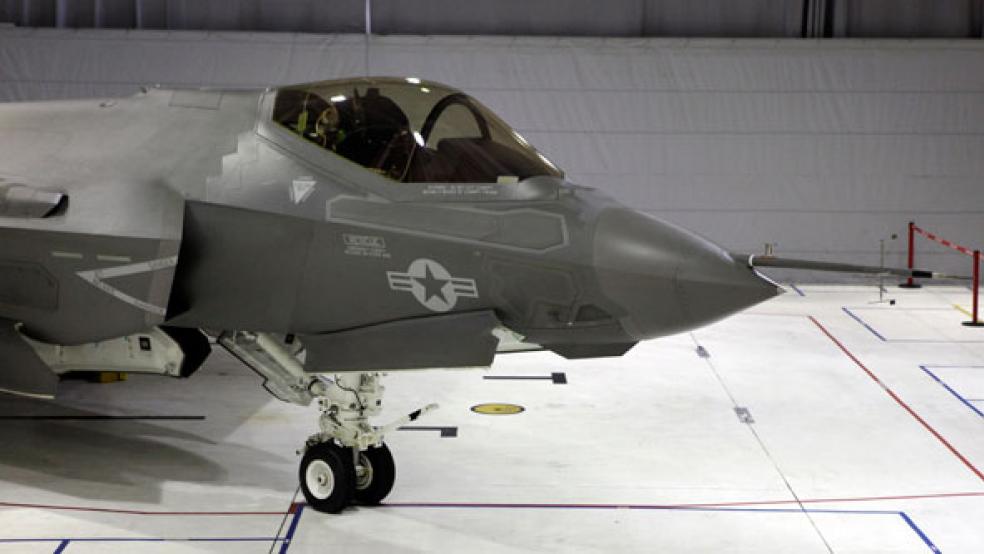Late Friday afternoon, less than a week after Defense Secretary Leon Panetta issued dire warnings about the pending defense cuts, the Pentagon announced that it had grounded its next generation F-35 fighter because of engine problems. This was the second time in two months the plane has been taken out of service.

Friday afternoon is Washington’s preferred time to release bad news and hope reporters, already thinking about the weekends, will turn a blind eye. But after this latest failure, the problems with the F-35 are simply too numerous to ignore.
Equally impossible to ignore is the $1.5 trillion price tag for one of the biggest failures in Pentagon history. $1.5 trillion is the cost of operating the air craft for 55 years, an amount that has been consistently increased as the program drags on. It’s the most expensive weapons system the Pentagon has ever commissioned. And as problems mount, there are growing concerns that the F-35 will never fly a combat mission.
“This was a huge mistake. We were warned about it in the 1990s by some prescient people. Those people were ignored,” said Winslow Wheeler, a long-time Congressional staffer who now is the director of the Straus Military Reform Project. “We’re living the consequences of the bad, fundamental design of the airplane and bad, fundamental design of the acquisition plan.”
PROBLEMS FROM THE START
The Pentagon commissioned the F-35 during the Clinton presidency. Lockheed Martin was chosen as the manufacturer.
Right now, each branch of the military has their own planes, meaning that numerous contracts existed with different contractors. Lockheed was expected to lower the cost of air defense by creating redundancies between the branches. It was ordered to produce three different versions of the F-35: the Marine version could take off and land vertically; the Navy version would be designed to take off from air craft carriers; and the Air Force version would take off from traditional runways. The Pentagon ordered nearly 2,500 planes for $382 billion, or fifty percent more than the original cost.
As the price soared, the Pentagon in 2010 deemed the program “too big to fail.” Yet it continues to fall short. Recent engine troubles are just the latest in a series of mechanical failures. A pilot was killed when oxygen to the cabin was cut off. The aircraft are running too hot, limiting their ability to operate in warm environments.
The original delivery date was supposed to be 2010. Then it was delayed until 2012. Now, it’s not expected to be in service until 2019.
But when they are put into active use, they have multiple tactical problems. They don’t have a long range, so they need to be close to the field of battle. They lack the weapons systems to adequately support ground forces. And they’re at a disadvantage in a dogfight because of limited turning capability.
Even if the planes were perfectly functional, they were built for a different era. The United States has unsurpassed global air superiority. If the F-35 order is filled, DOD will have 15 times as many planes as China. The F-35 was designed to fight a war between large military powers, not ones against insurgents in Mali.
NO POLITICAL OVERSIGHT
As failures have mounted, numerous lawmakers have slammed the Pentagon and Lockheed for their failure to deliver. Sen. John McCain, R-Az., in 2011 said “We cannot afford aircraft that doubles or triples the estimated cost.” Claire McCaskill, the Democratic Senator from Missouri, told Pentagon leaders that she “need[s] to know whose fault this is.” Yet the program continues to be funded.
In response to lawmaker complaints, former Defense Secretary Robert Gates restructured the program and fired its manager. Current Secretary Leon Panetta has also called for improvements to the program, and has said the delays are unacceptable.
But according to Wheeler, lawmakers on Capitol Hill and officials at the Pentagon refuse to acknowledge that they might be throwing money at a program that has not, and might not ever, produce a usable aircraft.
“It’s certainly not too big to fail. It already has failed,” he said. “Cancelling this thing and proceeding with a properly conceived aircraft would be cheaper and better.”





